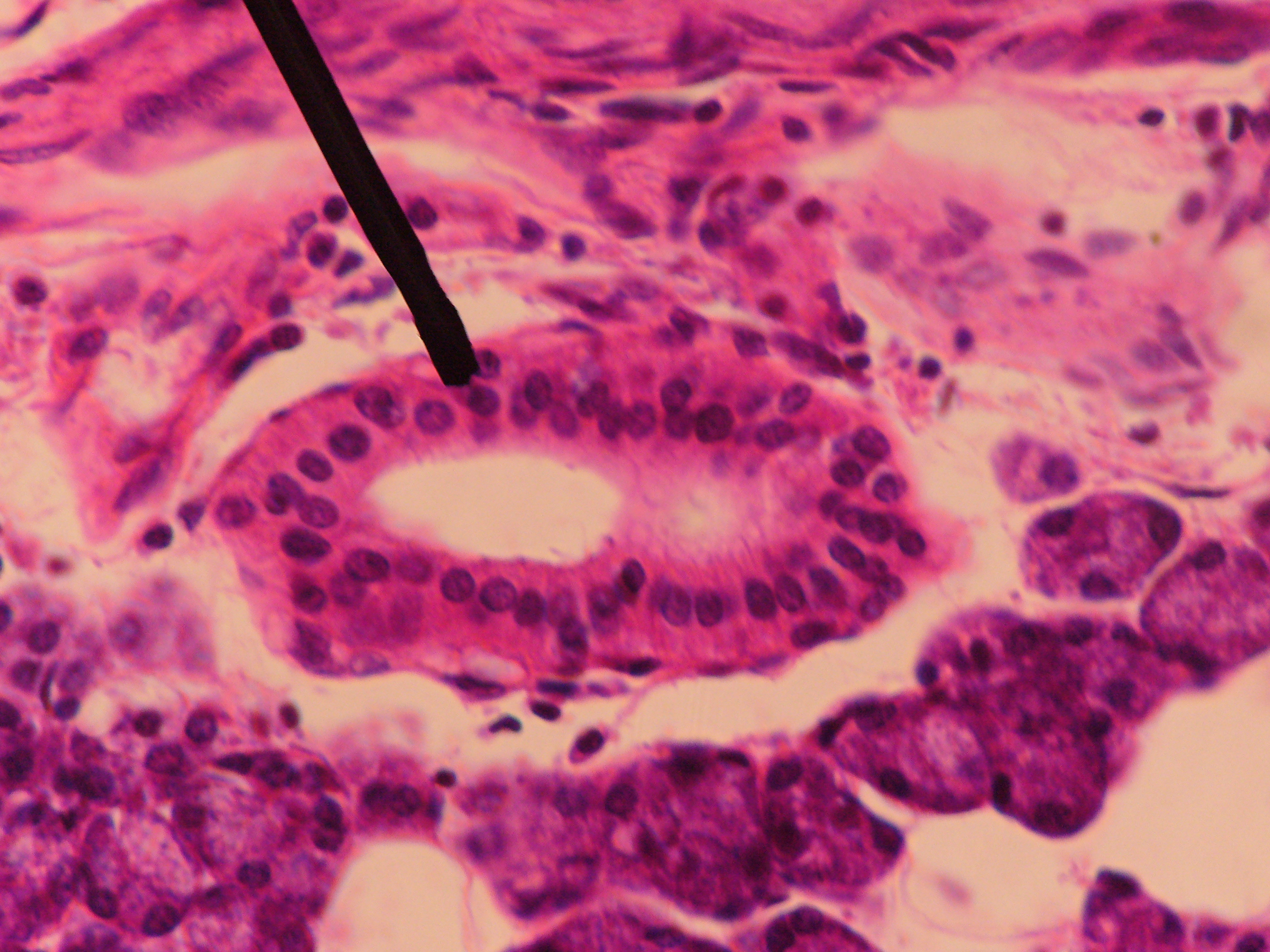duct (anatomy) on:
[Wikipedia]
[Google]
[Amazon]
In
File:Gray1025.png, Section of submaxillary gland of kitten. Duct semidiagrammatic. X 200.
File:Gray1173.png, Section of portion of mamma.
 A striated duct (Pflüger's ducts) is a
A striated duct (Pflüger's ducts) is a
Overview at uwa.edu.au
{{Authority control Glands
anatomy
Anatomy () is the branch of morphology concerned with the study of the internal structure of organisms and their parts. Anatomy is a branch of natural science that deals with the structural organization of living things. It is an old scien ...
and physiology
Physiology (; ) is the science, scientific study of function (biology), functions and mechanism (biology), mechanisms in a life, living system. As a branches of science, subdiscipline of biology, physiology focuses on how organisms, organ syst ...
, a duct is a circumscribed channel leading from an exocrine gland or organ.
Types of ducts
Examples include:Duct system
As ducts travel from the acinus which generates the fluid to the target, the ducts become larger and the epithelium becomes thicker. The parts of the system are classified as follows: Some sources consider "lobar" ducts to be the same as "interlobar ducts", while others consider lobar ducts to be larger and more distal from the acinus. For sources that make the distinction, the interlobar ducts are more likely to classified with simple columnar epithelium (or pseudostratified epithelium), reserving the stratified columnar for the lobar ducts.Intercalated duct
The intercalated duct, also called intercalary duct (ducts of Boll), is the portion of an exocrine gland leading directly from the acinus to a striated duct. The intercalated duct forms part of the intralobular duct. This duct has the thinnest epithelium of any part of the duct system, and the epithelium is usually classified as "low" simple cuboidal. They are found in both thepancreas
The pancreas (plural pancreases, or pancreata) is an Organ (anatomy), organ of the Digestion, digestive system and endocrine system of vertebrates. In humans, it is located in the abdominal cavity, abdomen behind the stomach and functions as a ...
and in salivary gland
The salivary glands in many vertebrates including mammals are exocrine glands that produce saliva through a system of ducts. Humans have three paired major salivary glands ( parotid, submandibular, and sublingual), as well as hundreds of min ...
s.
Striated duct
gland
A gland is a Cell (biology), cell or an Organ (biology), organ in an animal's body that produces and secretes different substances that the organism needs, either into the bloodstream or into a body cavity or outer surface. A gland may also funct ...
duct which connects an intercalated duct to an interlobular duct. It is characterized by the basal infoldings of its plasma membrane, characteristic of ion-pumping activity by the numerous mitochondria. Along with the intercalated ducts, they function to modify salivary fluid by secreting HCO3− and K+ and reabsorbing Na+ and Cl− using the Na-K pump and the Cl-HCO3 pump, making the saliva hypotonic.
Their epithelium
Epithelium or epithelial tissue is a thin, continuous, protective layer of cells with little extracellular matrix. An example is the epidermis, the outermost layer of the skin. Epithelial ( mesothelial) tissues line the outer surfaces of man ...
can be simple cuboidal or simple columnar.
Striated ducts are part of the intralobular ducts.
They are found in the submandibular gland, sublingual duct, and the parotid gland, but are more developed in the parotid gland.
They are not present in pancreas
The pancreas (plural pancreases, or pancreata) is an Organ (anatomy), organ of the Digestion, digestive system and endocrine system of vertebrates. In humans, it is located in the abdominal cavity, abdomen behind the stomach and functions as a ...
.
Intralobular duct
An intralobular duct is the portion of an exocrine gland inside a lobule, leading directly from acinus to an interlobular duct (between lobules). It is composed of two subdivisions, the intercalated duct and the striated duct. In the human mammary gland, the intralobular duct is a part of the glandular system that resides within the lobules. Lobules contain clusters of ducts whose secretory alveolies are drained by the intralobular duct. The intralobular ducts are usually lined with simple cuboidal epithelial cells that are lined by myoepithelial cells as well. The intralobular ducts of the lobules drain into the interlobular ducts between lobules. They can be seen in: *pancreas
The pancreas (plural pancreases, or pancreata) is an Organ (anatomy), organ of the Digestion, digestive system and endocrine system of vertebrates. In humans, it is located in the abdominal cavity, abdomen behind the stomach and functions as a ...
* salivary glands
The salivary glands in many vertebrates including mammals are exocrine glands that produce saliva through a system of Duct (anatomy), ducts. Humans have three paired major salivary glands (Parotid gland, parotid, Submandibular gland, submandibula ...
See also
* Ductal carcinoma *Endocrine gland
The endocrine system is a network of glands and organs located throughout the body. Along with the nervous system, it makes the neuroendocrine system, which controls and regulates many of the body's functions. Endocrine glands are ductless gland ...
* List of distinct cell types in the adult human body
References
External links
Overview at uwa.edu.au
{{Authority control Glands